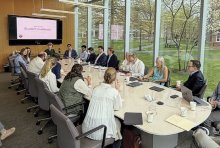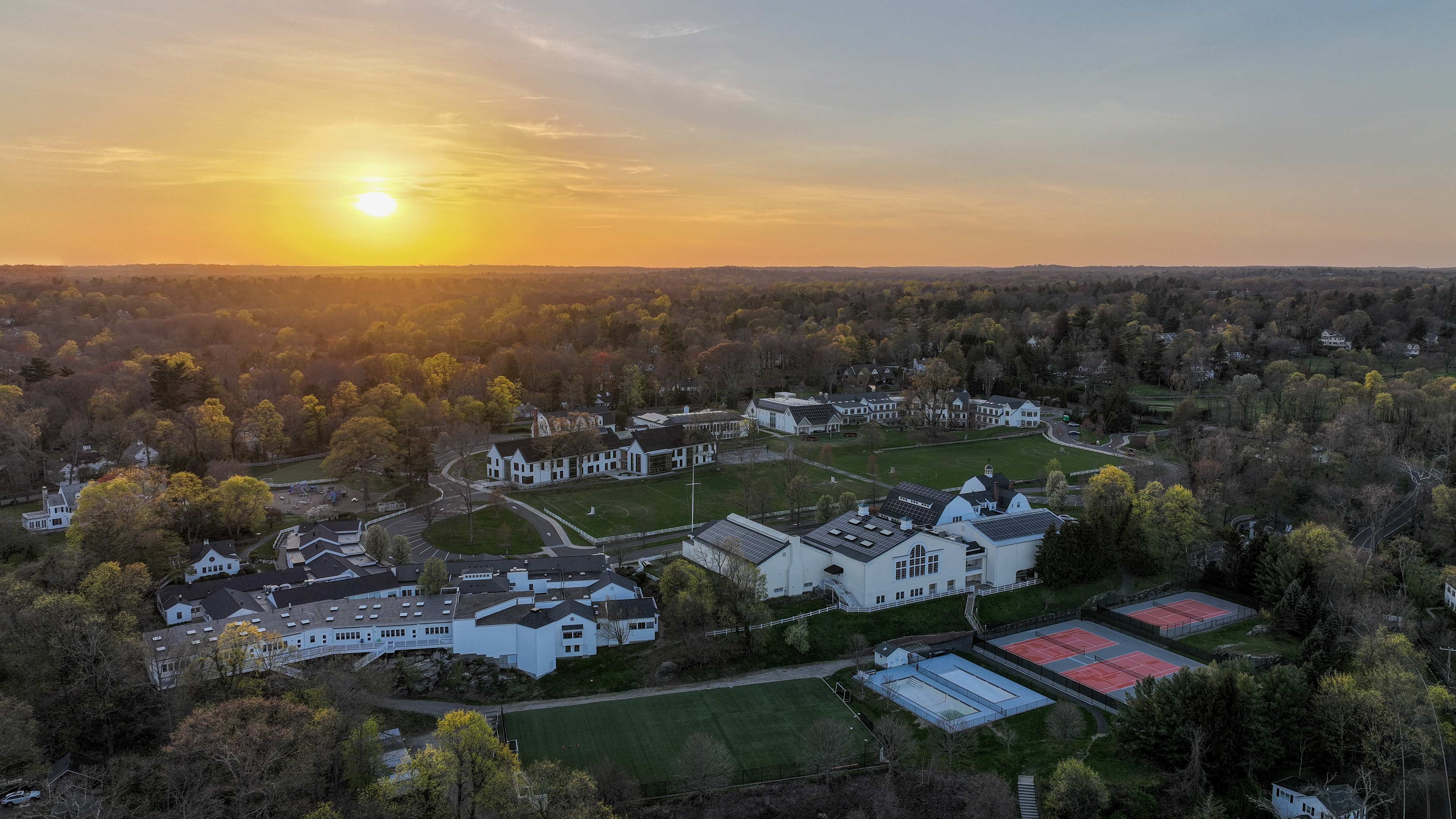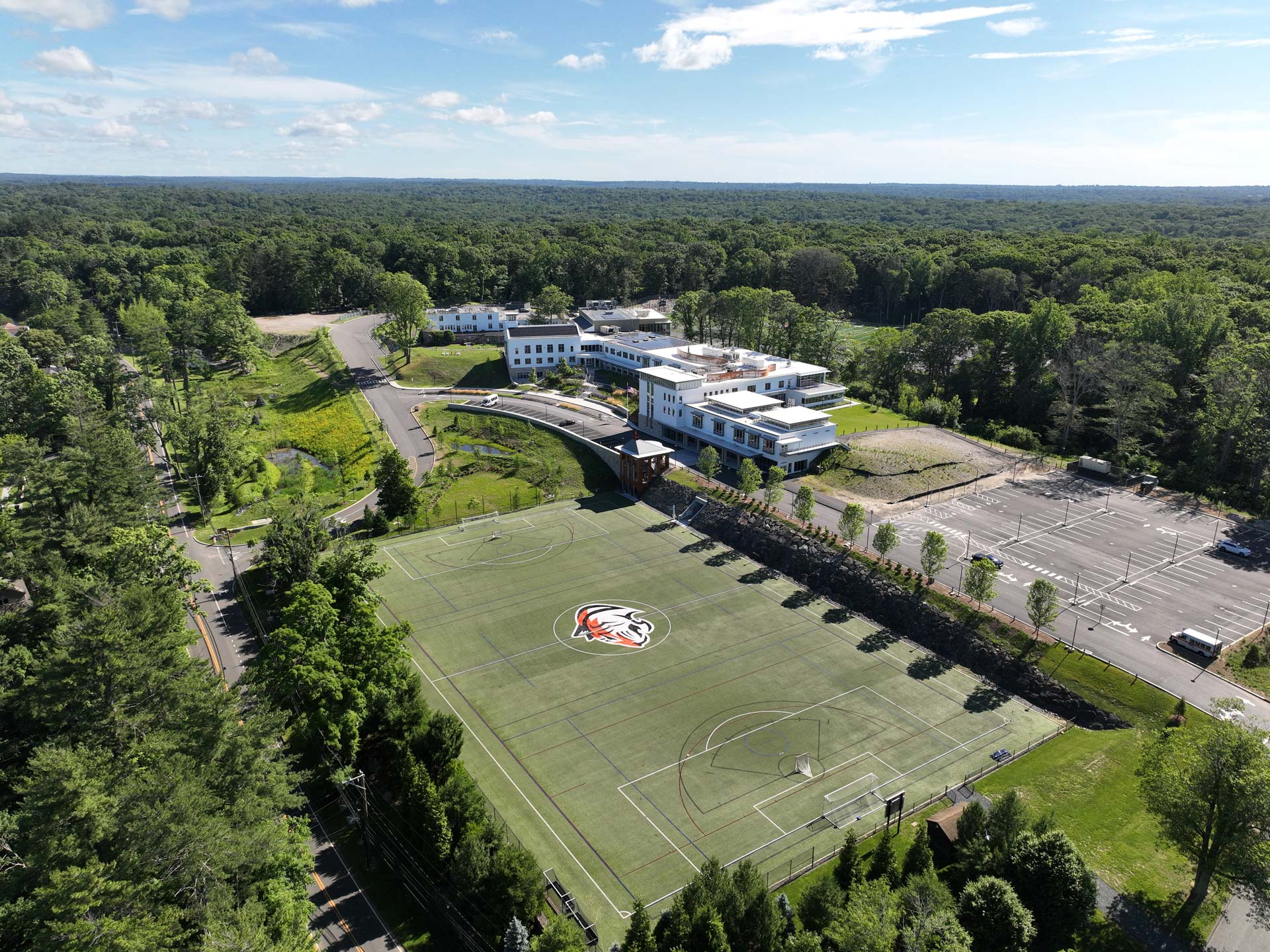
By DR. ANDREW RUOSS, Asst. Head of Upper School for Academic Programs; VPAL+GCDS Coordinator & LILY BREITFELDER, GCDS Class of 2026
On a Friday morning this past April, in a conference room on the campus of Harvard Business School (HBS), a discussion was heating up. Harvard faculty and administrators were locked in conversation with a group of students—all GCDS Upper Schoolers—discussing the future of high school education. Sitting around the conference table with the students and professors, GCDS faculty jumped into the dialogue, building on their students’ points about the efficacy of different applied education approaches and technological tools. Into the afternoon, the conversation continued to evolve as GCDS students and faculty presented data, analysis, and proposals, and the Harvard faculty interjected with their own ideas, experiences, and research.
The meeting was a culminating feedback and analysis session for a yearlong pilot partnership between the Office of the Vice Provost for Advances in Learning (VPAL) at Harvard and the GCDS Upper School. The two institutions collaborated in pursuit of three common goals: embracing educational innovation, experimenting with new pedagogies, and channeling their collaboration toward societal impact. For the past year, about 70 students and a team of six faculty across five departments at Country Day have worked with the VPAL team to test and analyze innovative pedagogical tools for university and professional instruction.
This initiative speaks to the core design of the Upper School at Country Day. Six years ago, the Upper School was launched with one mission: to leverage the strength of the GCDS community, and the school’s century of tradition and excellence in education, in order to create opportunities for students to apply their learning to the problems that define the contemporary world. Institutional partnerships, such as this recent pilot with Harvard VPAL, have been crucial to this effort—opening opportunities for our faculty and students to collaborate on strategic projects with universities, companies, and government offices around the New York Metro region and across the country.
Partnering with Harvard VPAL
The mission of the Upper School led to a partnership with the Vice Provost’s Office at Harvard, which is focused on similar goals of scaling applied and interdisciplinary skills at the university and professional levels. Harvard’s VPAL team coordinates academic innovation across all 11 schools of Harvard University. The Vice Provost’s Office leads Harvard’s efforts to channel resources and expertise to chart the future of learning and research. The office focuses on “extending the reach of Harvard’s excellence through key partnerships and agreements with institutions and businesses around the world.”
As Vice Provost Dr. Bharat Anand noted about the partnership with GCDS: “We came in with common aspirations here.”
While Harvard VPAL has primarily focused on undergraduate, professional, and lifelong training, the office has begun to explore opportunities to apply these initiatives to secondary education.
“If we can create amazing educational content for the core fundamental courses and be able to share this with schools across the country and the world in ways that students might be able to benefit with the right local support, honestly, that’s a game changer,” said Dr. Anand about the GCDS pilot.
Over the past year, a GCDS faculty team, representing math, computer science, design, and economics fields, has worked with the VPAL team to translate tools and curricula from Harvard courses into GCDS classrooms. Economics courses are engaging with the Economics for Managers course developed by faculty at Harvard Business School, design and filmmaking courses are incorporating HBS Design Thinking curricula, and math and computer science courses are employing sustainability and data analysis programs developed by Harvard faculty.
But the students and faculty were not just piloting the classes, they were also assessing the programs’ impact on their learning. Students engaged in periodic surveying and narrative feedback, and then a team of students and faculty analyzed the incoming data. Advanced Computer Science students also interrogated the HBS digital plat- form and developed additional tools and suggestions.
The Upper School teaching team met weekly to discuss how the Harvard courses resonated with their students, how the courses were implemented— whole cloth, flipped classroom, or hybrid—and which Harvard tools most impacted particular learning profiles. The GCDS faculty involved also represented deep experience in college-level teaching, professional development, and e-learning design. They included former faculty members of Savannah College of Art and Design, Virginia Commonwealth University, and the architect of Columbia University’s first e-learning platform.
“Working with the Harvard team enriched our conversations as faculty, as well as our work with our students. We tested different approaches to design thinking in my classes—working with the kids to map out which methods amplified their ability to design and build solu - tions to complex societal problems,” described Dr. Louise Wales, Upper School Arts Chair.
The Upper School’s priority of positioning students as learners alongside their teachers has also driven this partnership. “The collaboration between Harvard and GCDS challenged us to translate our experiences as learners into useful insights for the Harvard team,” said 11th Grader Jessie Colin. “In the day-long meeting with professors and university leaders, it was exciting to discuss and reimagine the future of education—a future which my peers and I will experience.”
Advancing Learning Innovations at Scale
As the Vice Provost’s Office approached the partnership with the ultimate goal of scaling to secondary education nationwide, and potentially globally, the student and faculty teams worked together to focus their feedback on how the experience at GCDS could offer insights for broader application. “Over and over, our students’ suggestions were spot on with the ideas and proposals that the Harvard team had heard internally,” said Computer Science Chair Gordie Campbell, who attended the meetings. ”It’s validating when student insights align perfectly with those from established professionals. It suggests your students have developed a strong understanding of the field and are thinking at an advanced level—and thinking about the potential impact of their ideas.”
Students were also at the heart of conceptualizing opportunities for scalability of the high school partnership beyond GCDS. Lily Breitfelder, a GCDS junior, focused her Advanced Junior Thesis research on organizational psychology and studied the partnership as it evolved, evaluating the work of both institutions’ faculty through technical models of institutional change. She was embedded in every faculty meeting and interviewed GCDS faculty and administrators, as well as members of the VPAL team at Harvard.
There were inevitable hurdles along the way: legal policies, technical structures, and translating college programs to a high school. But as Dr. Anand reflected, “the fact that we got over those speed bumps is a testament to the efforts of everyone involved. It almost underscores that this was the right pilot.”
Moving forward, the Upper School plans to continue to expand the use of Harvard VPAL modules as a powerful addition to the curriculum. The GCDS faculty team is working to grow the initiative to more departments and to employ the Harvard tools, with the goal of co-creating course materials and applied experiences to be developed at GCDS and, ultimately, to be shared across the VPAL platform with high schools across the country. Exciting possibilities lay ahead as GCDS and Harvard VPAL continue to work together on a shared vision for the future of education.
Since its founding, GCDS has focused on cultivating the strengths of its students and instilling the value that achievement is realized in channeling personal growth toward the public good. As GCDS approaches its centennial year, our faculty and students are engaging directly with cutting-edge tools and working with partners like Harvard VPAL to craft future focused concepts and education models. Thinking across disciplines; applying learning to critical, unsolved societal problems; and leveraging technology and design to enhance learning—this is a shared mission of these two institutions and a requirement for impact in a rapidly evolving world.
“Education does not scale itself; the people do. This unique partnership will allow our faculty and Harvard faculty to create programming in key areas of student development in secondary education. As we think about scaling to a more general audience, our partnership will further emphasize our mission of redefining rigor and creating interdisciplinary connections angled toward preparing our students to address the problems of a rapidly changing world.”—Coleman Hall, Upper School Math Chair
Faculty Team:
Dr. Louise Wales, Arts Chair
Coleman Hall, Math Chair
Gordie Campbell, Creative Applied Technologies/CS Chair
Andy Dutcher, Economics + Math Faculty
Kathleen Bliss, Math Faculty
Dr. Andrew Ruoss, Asst. Head of Upper School for Academic Programs; GCDS + VPAL Coordinator
Student Team:
Imran Iftikar ’25
Harrison Servedio ’25
Lily Breitfelder ’26
Charlie Moloney ’26
Jessie Colin ’26
Mia Stark ’26










.JPG&command_2=resize&height_2=85)





.jpg&command_2=resize&height_2=85)





